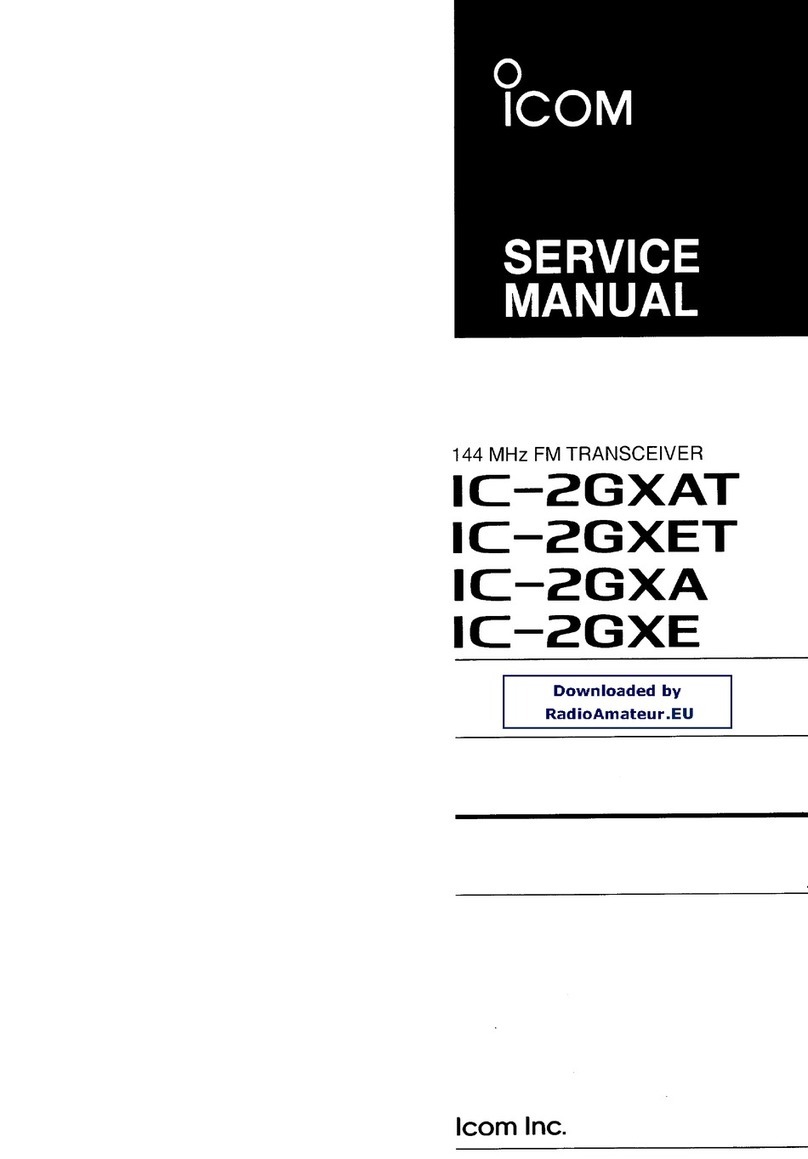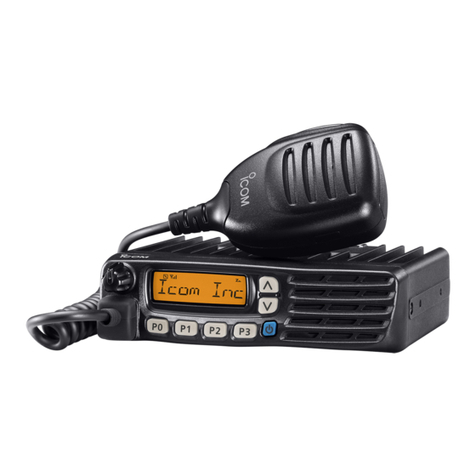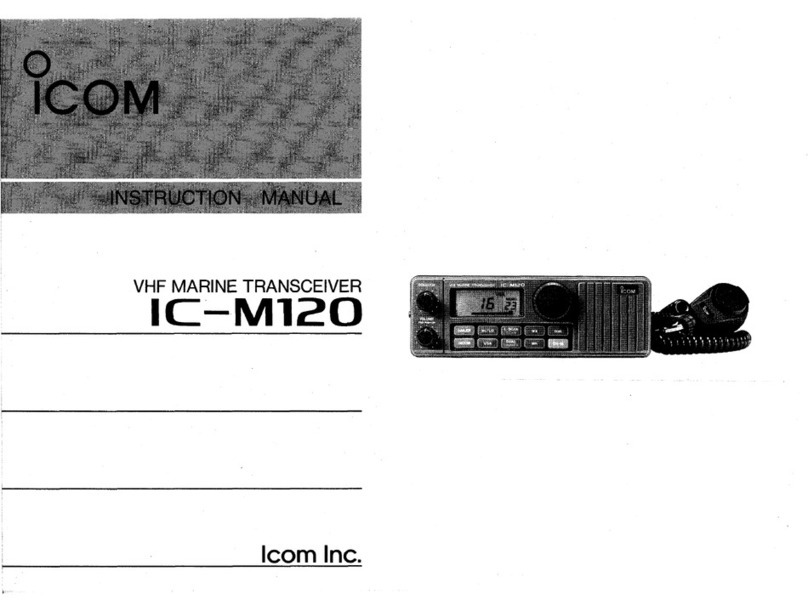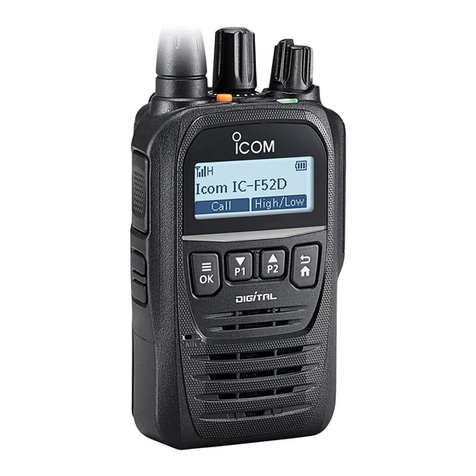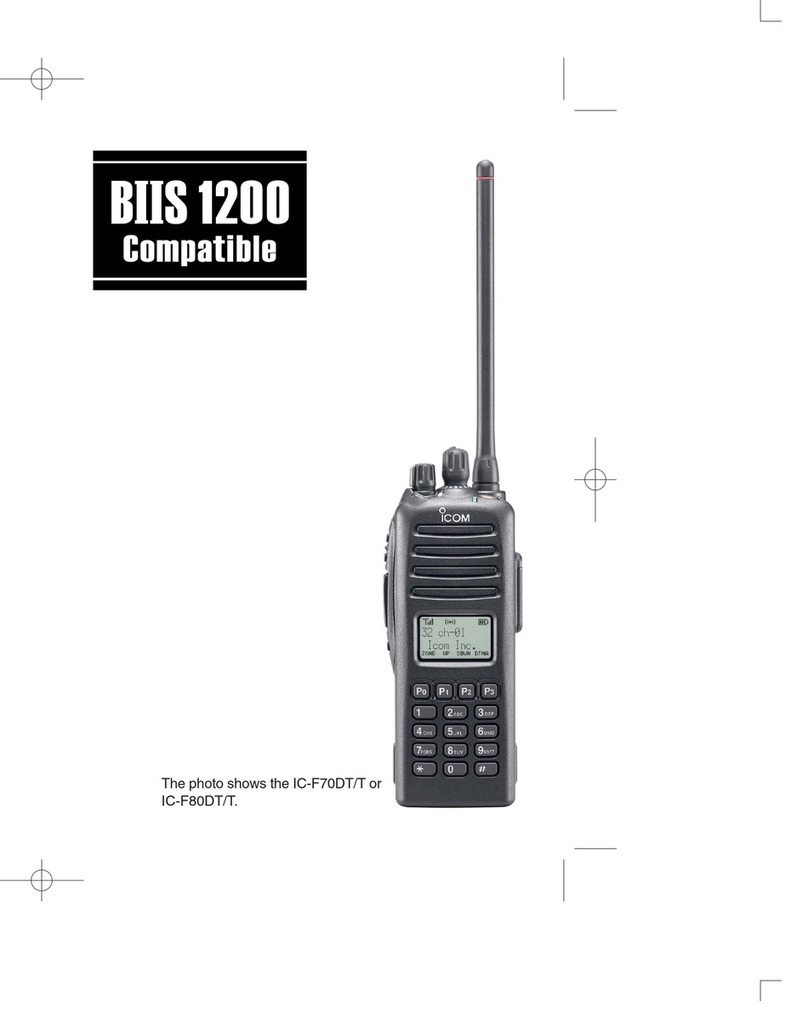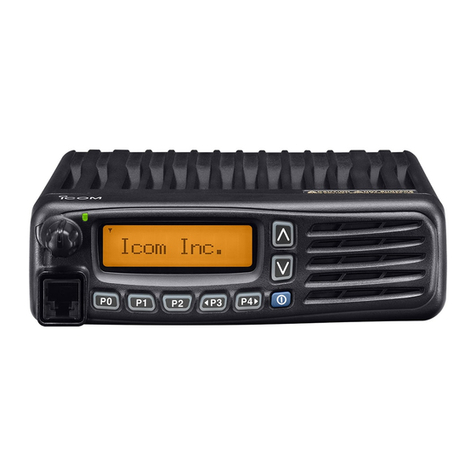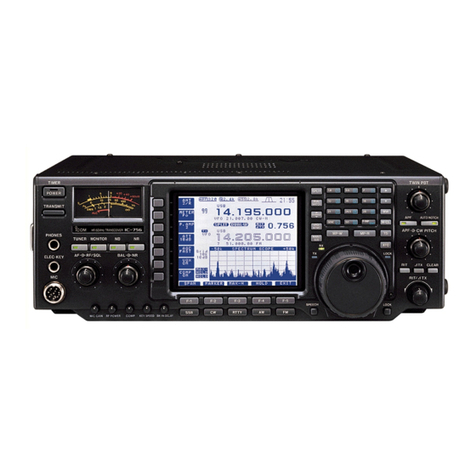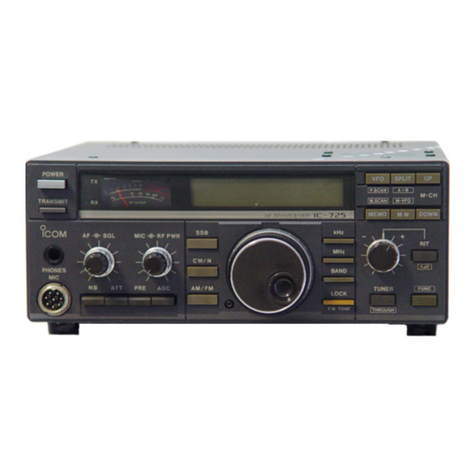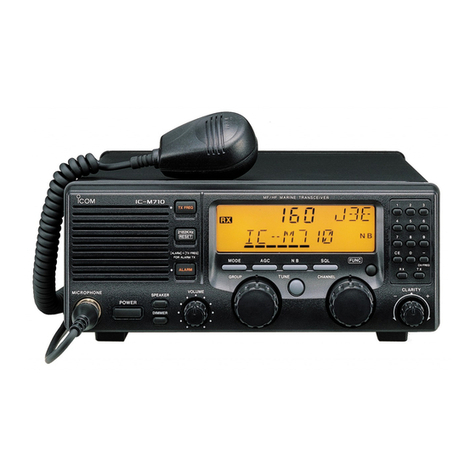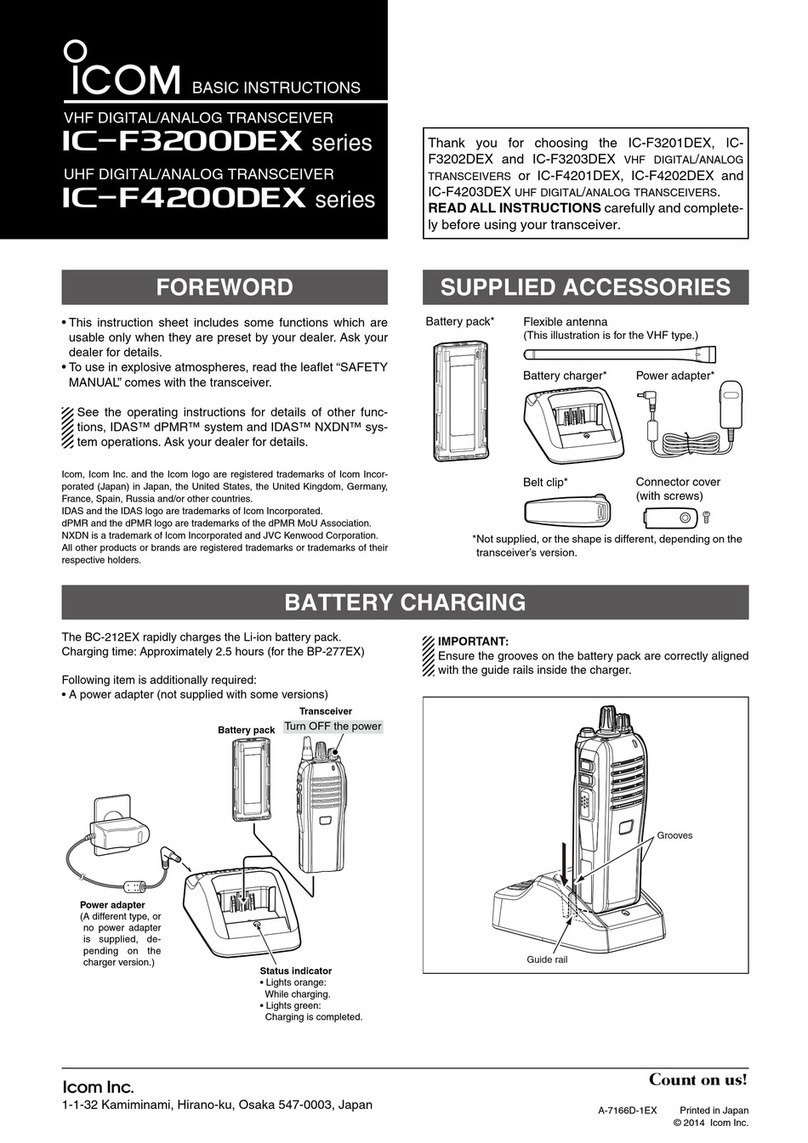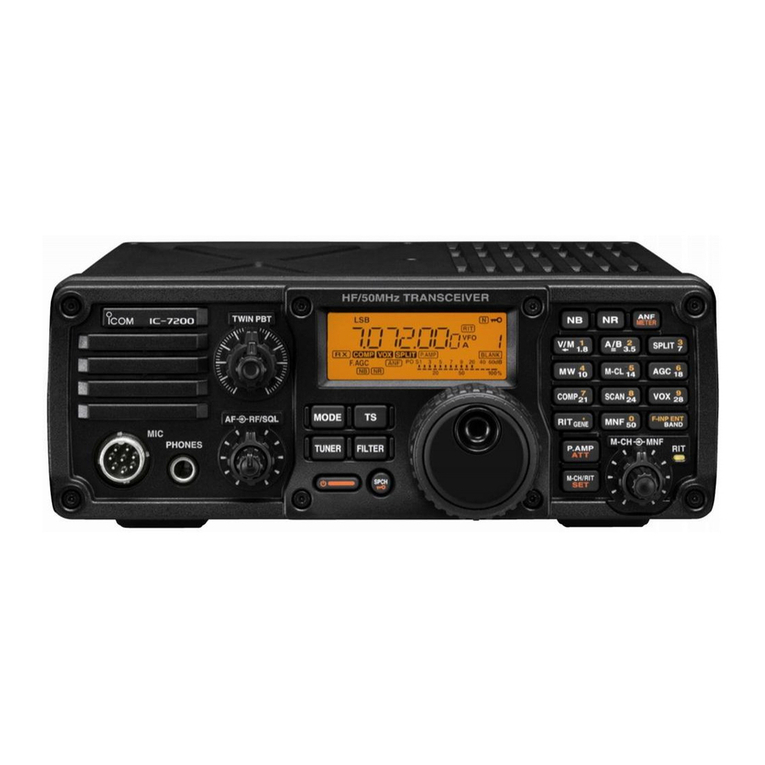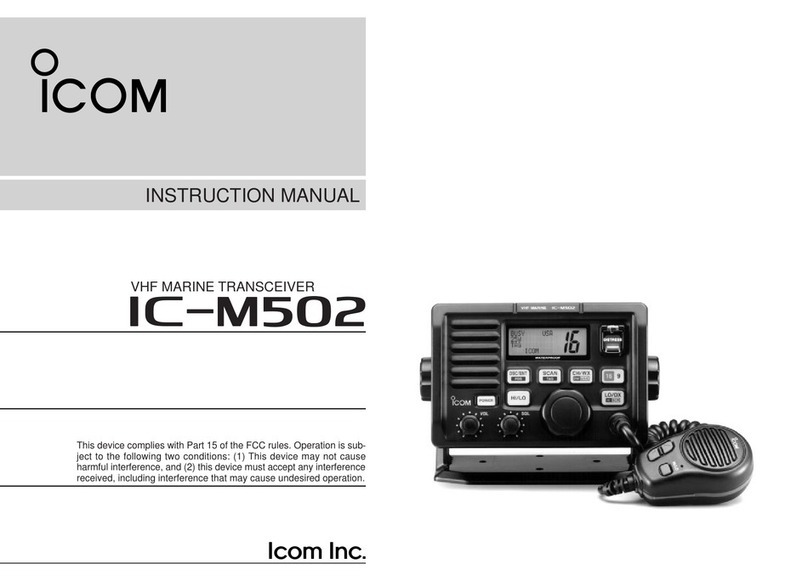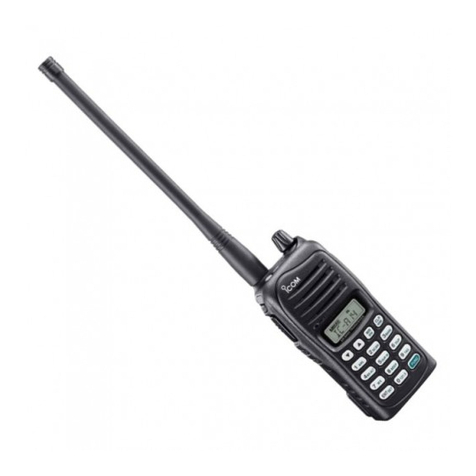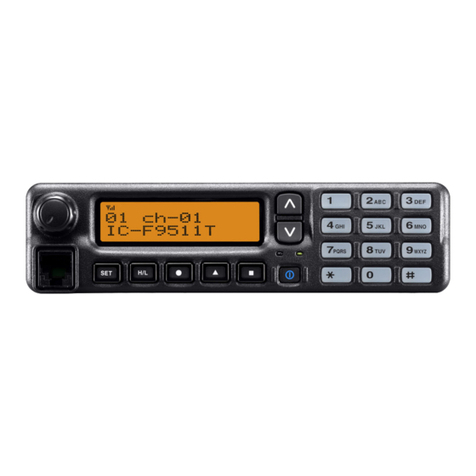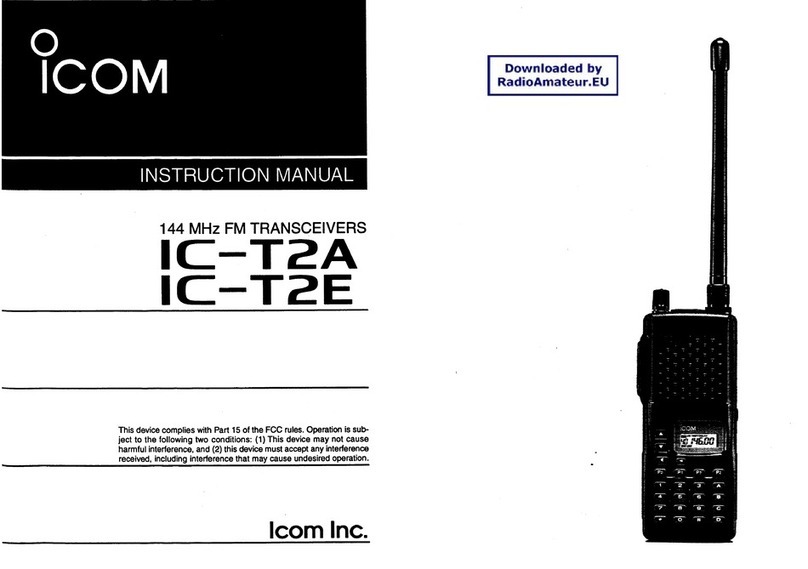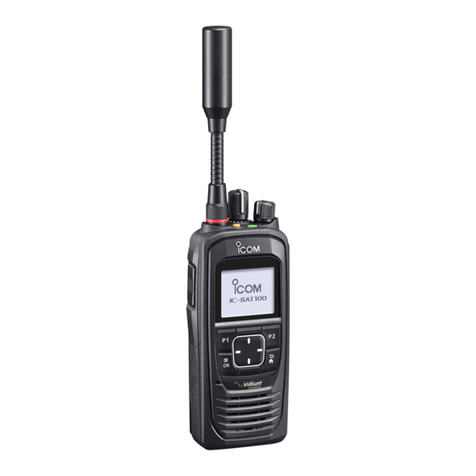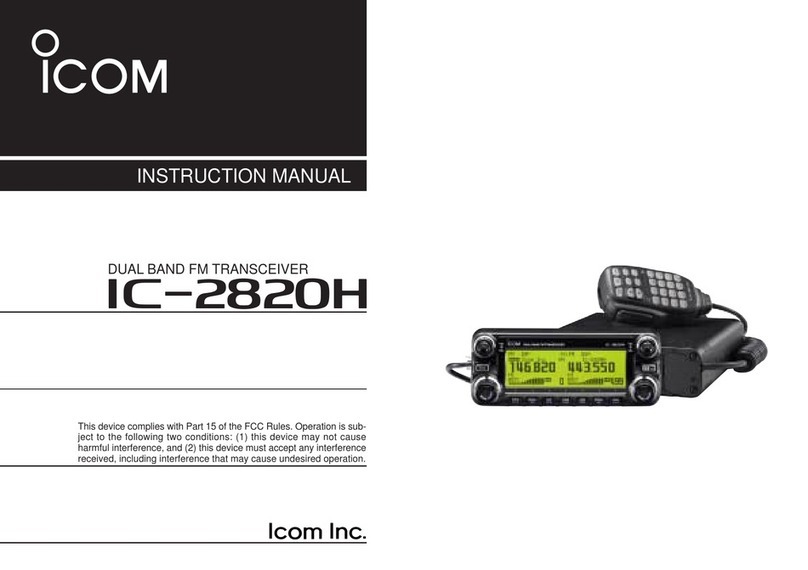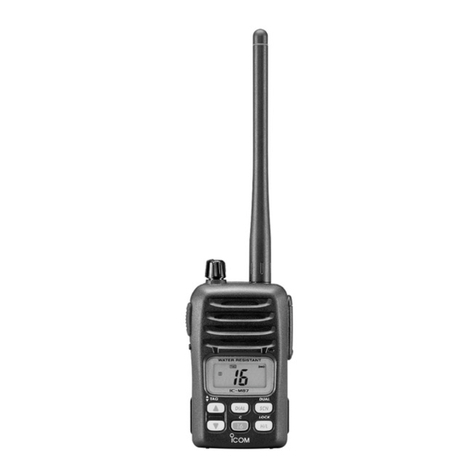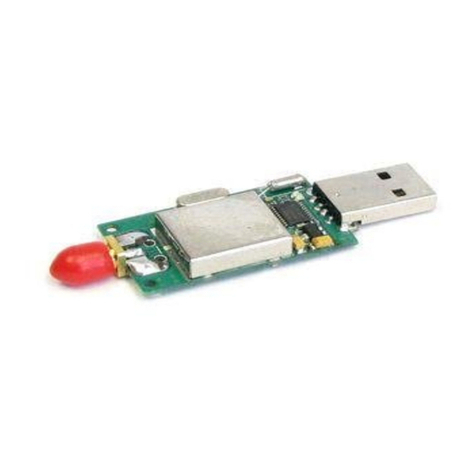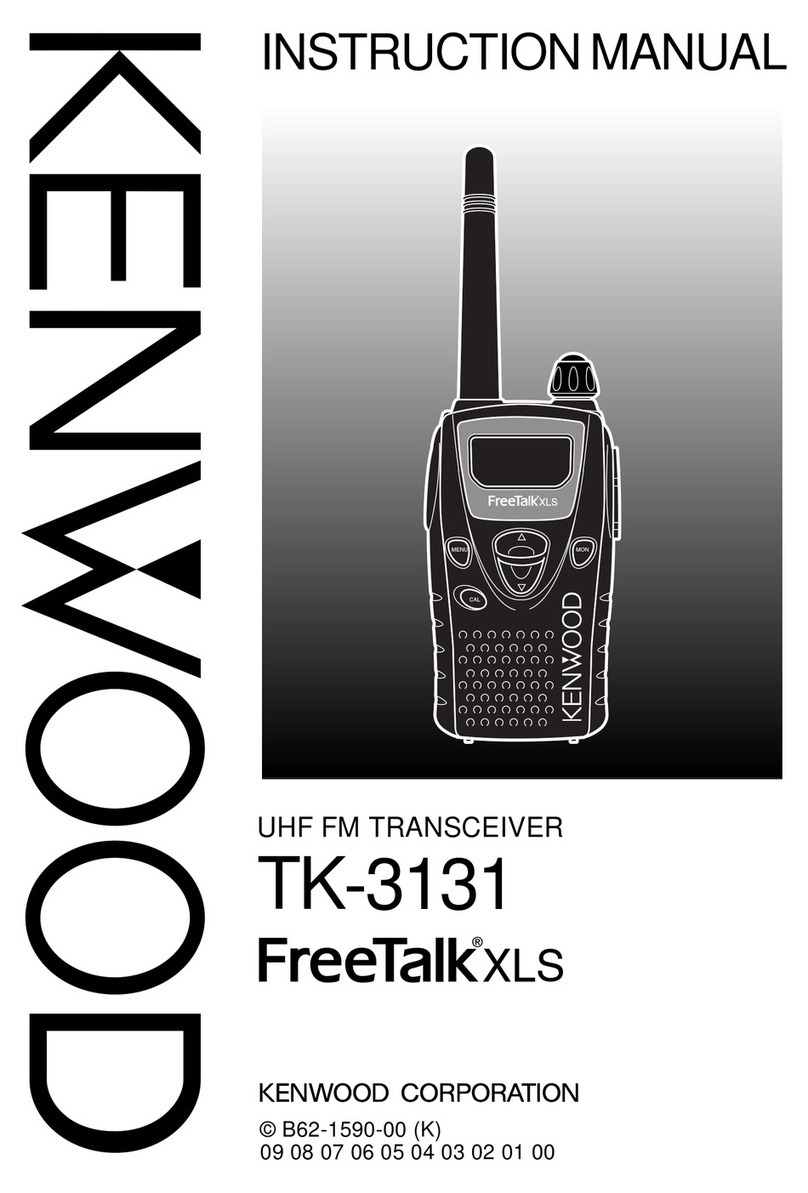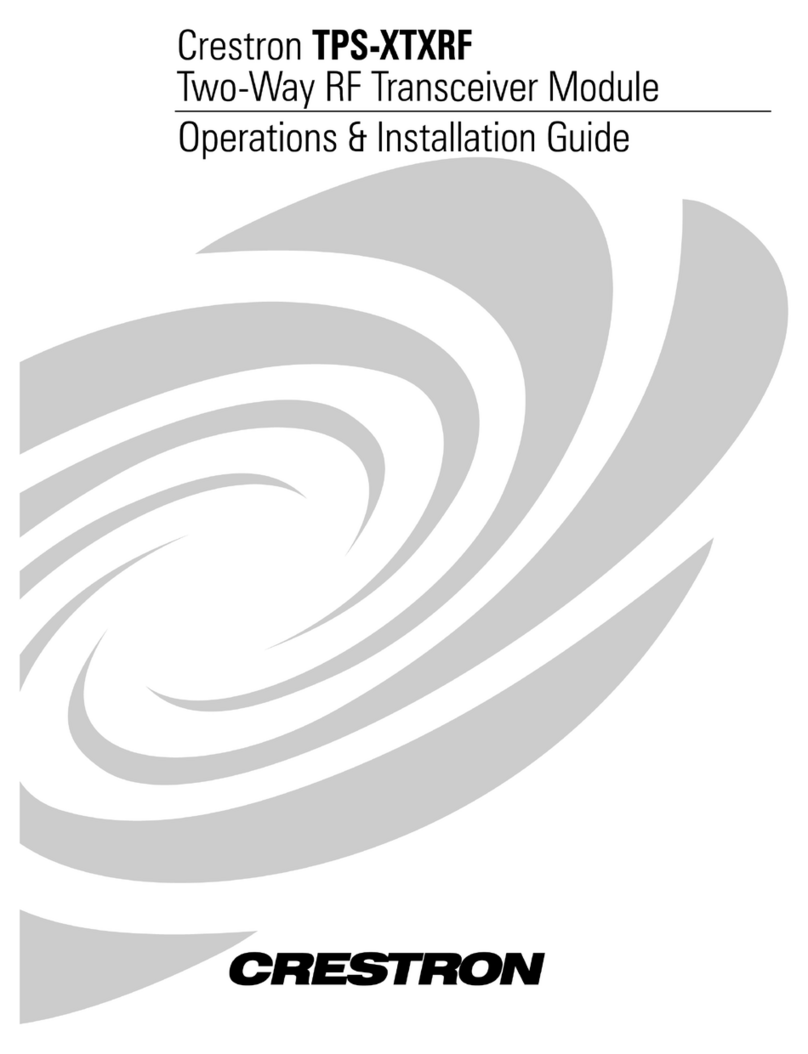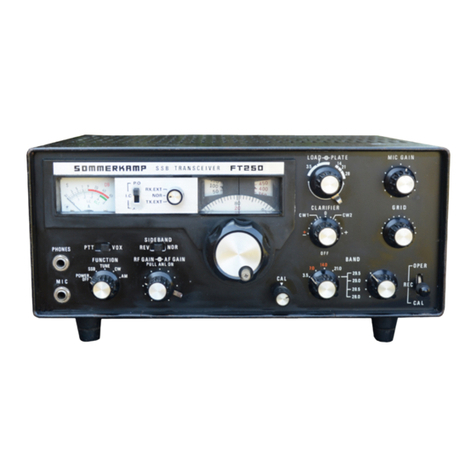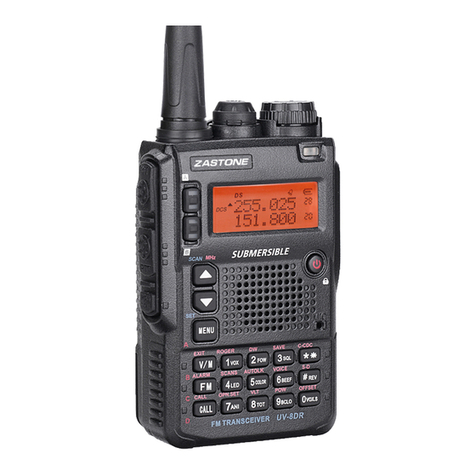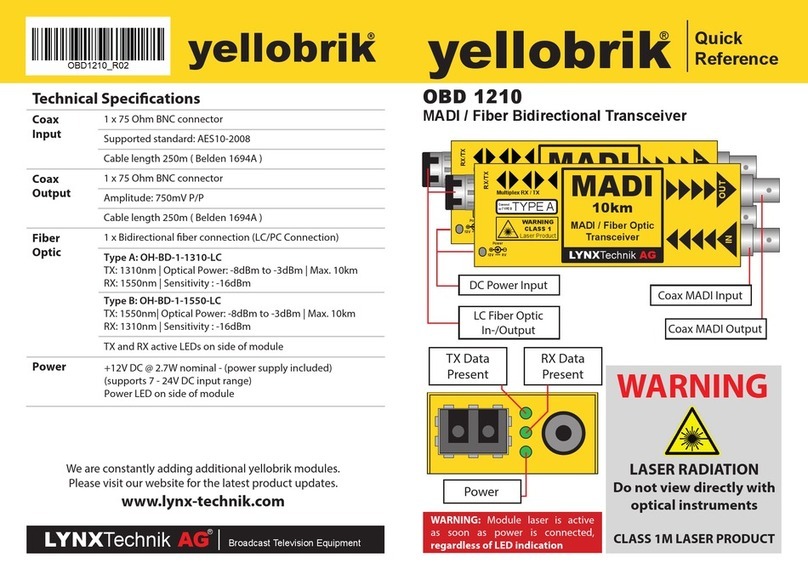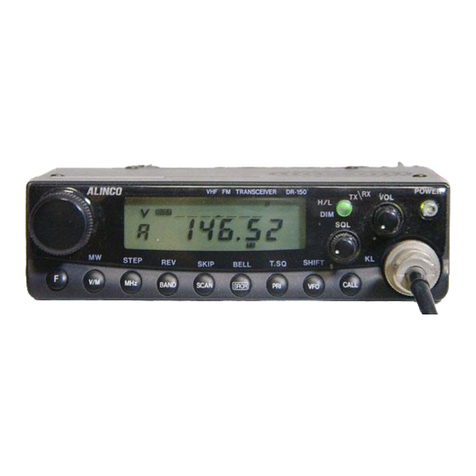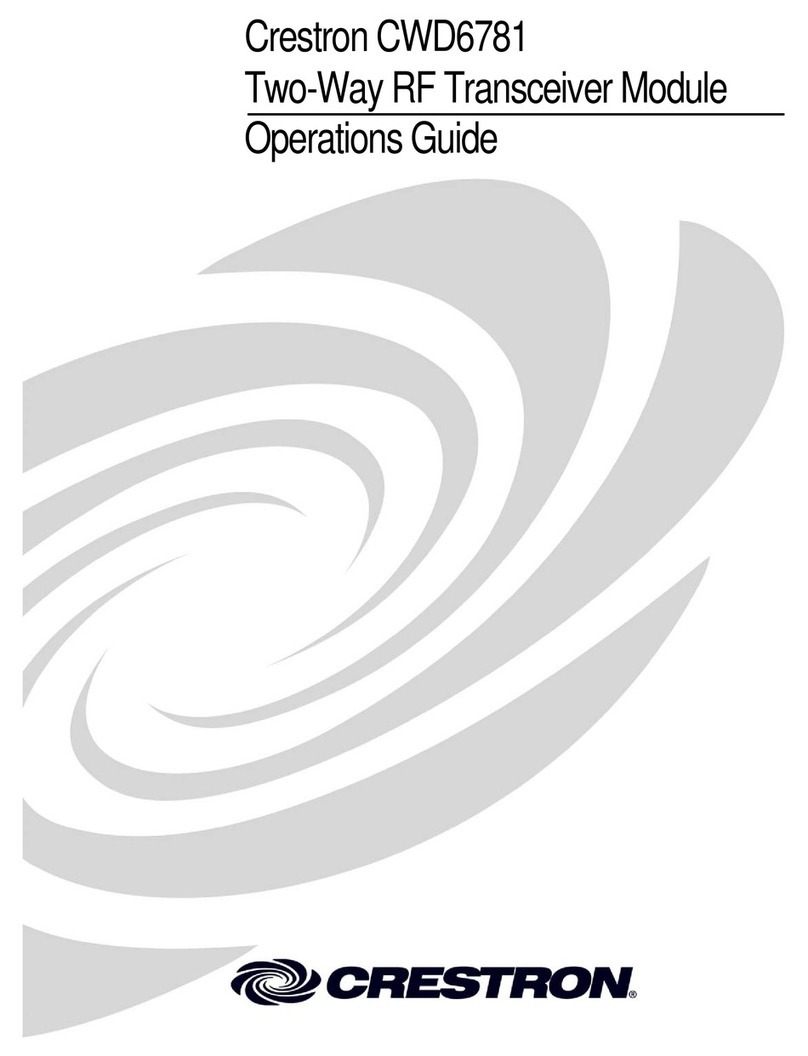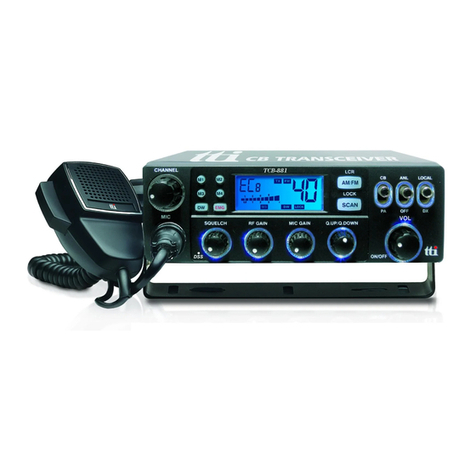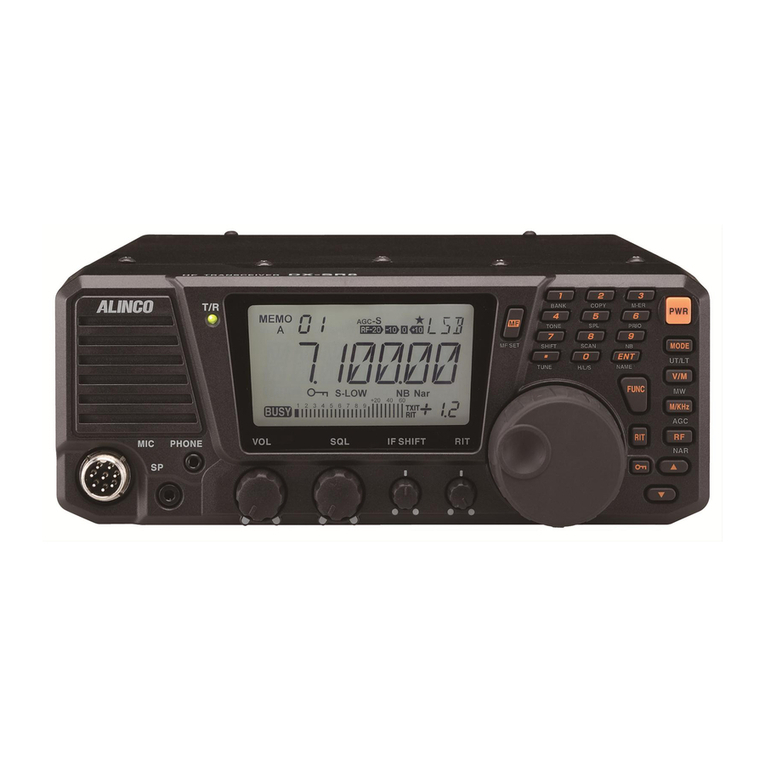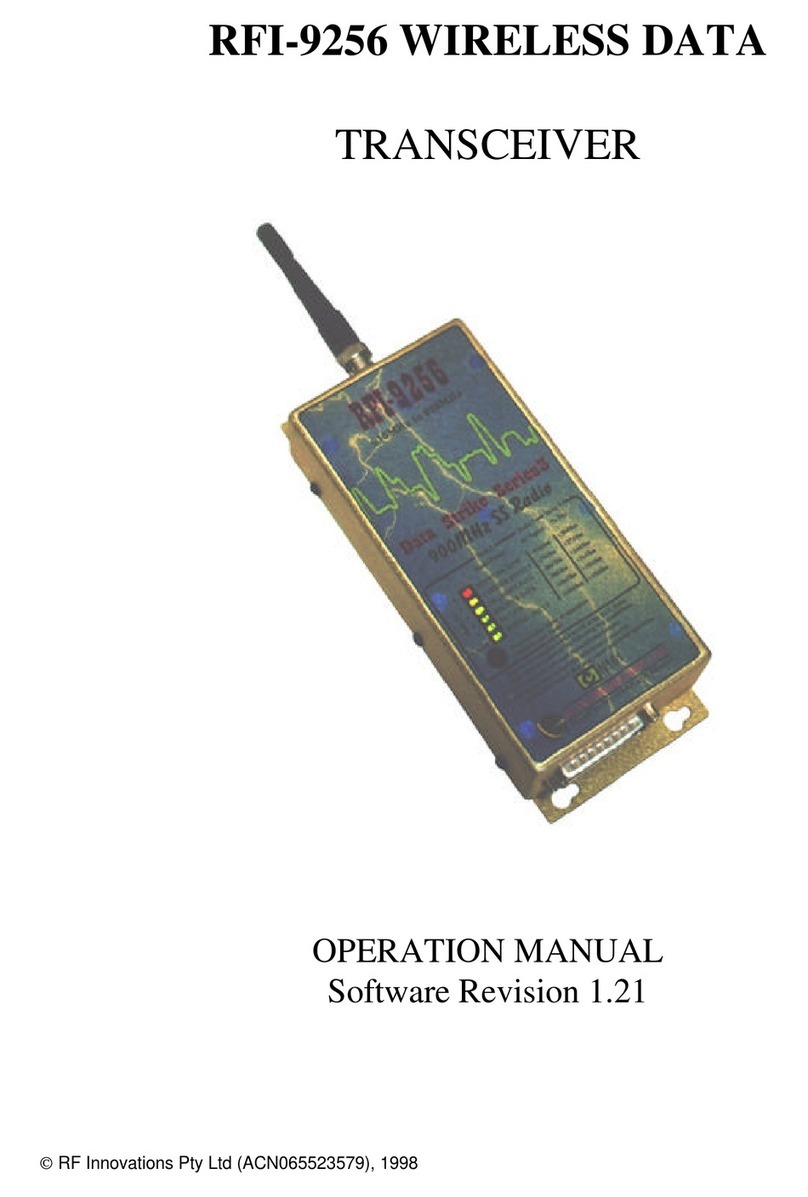Icom IC-7100 User manual

S-15008XZ-C1
July 2013
HF/VHF/UHF ALL MODE TRANSCEIVER

This service manual describes the latest technical information
for the IC-7100 HF/VHF/UHF ALL MODE TRANSCEIVER, at
the time of publication.
NEVER connect the transceiver to an AC outlet or to a DC
power supply that uses more than the specified voltage. This
will ruin the transceiver.
DO NOT expose the transceiver to rain, snow or liquids.
DO NOT reverse the polarities of the power supply when con-
necting the transceiver.
DO NOT apply an RF signal of more than 20 dBm (100 mW) to
the antenna connector. This could damage the transceiver’s
front-end.
To upgrade quality, any electrical or mechanical parts
and internal circuits are subject to change without notice
or obligation.
MODEL VERSION VERSION
NUMBER
IC-7100
USA #02
EUR #03
EUR-01 #04
ITR #05
ESP #06
TPE #07
KOR #08
CHN #09
FRA #12
EXP #13
Be sure to include the following four points when ordering
replacement parts:
1. 10-digit Icom part number
2. Component name
3. Equipment model name and unit name
4. Quantity required
<ORDER EXAMPLE>
1110003491 S.IC TA31136FNG IC-7100 MAIN UNIT 5 pieces
8820001210 Screw 2438 screw IC-7100 Top cover 10 pieces
Addresses are provided on the inside back cover for your
convenience.
ORDERING PARTS
1. Make sure that the problem is internal before dis-assem-
bling the transceiver.
2. DO NOT open the transceiver until the transceiver is dis-
connected from its power source.
3. DO NOT force any of the variable components. Turn them
slowly and smoothly.
4. DO NOT short any circuits or electronic parts. An insulated
tuning tool MUST be used for all adjustments.
5. DO NOT keep power ON for a long time when the trans-
ceiver is defective.
6. DO NOT transmit power into a Standard Signal Generator
or a Sweep Generator.
7. ALWAYS connect a 40 dB to 50 dB attenuator between the
transceiver and a Deviation Meter or Spectrum Analyzer,
when using such test equipment.
8. READ the instructions of the test equipment thoroughly
before connecting it to the transceiver.
REPAIR NOTES
INTRODUCTION CAUTION
Icom, Icom Inc. and the Icom logo are registered trademarks of Icom Incorporated (Japan) in Japan, the United States, the
United Kingdom, Germany, France, Spain, Russia and/or other countries.

TABLE OF CONTENTS
SECTION 1 SPECIFICATIONS
SECTION 2 INSIDE VIEWS
SECTION 3 CIRCUIT DESCRIPITON
3-1 RECEIVER CIRCUITS...................................................................................... 3-1
3-2 TRANSMITTER CIRCUITS............................................................................... 3-2
3-3 FREQUENCY SYNTHESIZER CIRCUITS ....................................................... 3-4
3-4 VOLTAGE BLOCK DIAGRAM ........................................................................... 3-4
3-5 PORT ALLOCATIONS ...................................................................................... 3-5
SECTION 4 ADJUSTMENT PROCEDURES
4-1 PREPARATION ................................................................................................. 4-1
4-2 FREQUENCY ADJUSTMENT .......................................................................... 4-3
4-3 TRANSMIT ADJUSTMENT............................................................................... 4-4
4-4 RECEIVE ADJUSTMENT ................................................................................. 4-5
SECTION 5 PARTS LIST
SECTION 6 MECHANICAL PARTS
SECTION 7 BOARD LAYOUTS
SECTION 8 WIRING DIAGRAM
SECTION 9 BLOCK DIAGRAM
SECTION 10 VOLTAGE DIAGRAM

1-1
SECTION 1
.
SPECIFICATIONS
'ENERALD
s&REQUENCYCOVERAGE UNIT-(Z
Receive
0.030000 –199.999999*1*2
400.000000 –470.000000*1*2
Transmit
1.800000 – 1.999999*2, 3.500000 – 3.999999*2,
5.255000 – 5.405000*1*3,
5.332000*3*4, 5.348000*3*4, 5.358500*3*4,
5.373000*3*4, 5.405000*3*4,
7.000000 – 7.300000*2, 10.100000 – 10.150000*2,
14.000000 – 14.350000*2, 18.068000 – 18.168000*2,
21.000000 – 21.450000*2, 24.890000 – 24.990000*2,
28.000000 – 29.700000*2,50.000000 – 54.000000*2,
70.000000 – 70.500000*2, 144.000000 – 148.000000*2,
430.000000 –450.000000*2
*
1Some frequency ranges are not guaranteed.
*
2Depending on version. *3USA version only.
*
4Center frequency.
s-ODE 53",3"#72449!-&-
WFM (RX only), DV
s.OOFMEMORYCHANNELS #((99CH × 5 bank)
s.OOFSCANEDGEMEMORYCHANNELS
6 CH (2 × 3 edges)
s.OOFCALLCHANNELS #((2 × 2 band)
s!NTENNACONNECTOR 3/×2
sAntenna impedance: 50 ø
s5SABLETEMPERATURERANGE
–10˚C to +60˚C;
+14˚F to +140˚F
s&REQUENCYSTABILITY ,ESSTHANÒPPMMINUTES
after power ON. (0˚C to +50˚C;
+32˚F to +122˚F at 430 MHz band)
s&REQUENCYRESOLUTION (Z
s0OWERSUPPLY 6$#Ò
(negative ground)
s0OWERCONSUMPTION
Transmit
Max. power: 22.0 A
Receive
Standby: 0.9 A
Max. audio: 1.2 A
s$IMENSIONSPROJECTIONSNOTINCLUDED
Main unit: 167(W) ×58(H) ×225(D) mm;
6.6(W) ×2.3(H) ×8.9(D) in
Controller: 165(W) ×64(H) ×78.5(D) mm;
6.5(W) ×2.5(H) ×3.1(D) in
s7EIGHTAPPROXIMATELY
Main unit: 2.3 kg; 5.1 lb
Controller: 0.5 kg; 1.1 lb
s!##CONNECTOR PIN
s$!4!CONNECTOR CONDUCTORDMM1⁄10″)
s$!4!CONNECTOR PIN
s2%-/4%CONNECTOR CONDUCTORDMM1⁄8″)
TransmitterD
s/UTPUTPOWER(at 13.8 V DC/+25˚C): (continuously adjustable)
&REQUENCYBAND /UTPUTPOWER
HF/50 MHz 2 to 100 W (AM: 1 to 30 W)*
70 MHz 2 to 50 W (AM: 1 to 15 W)*
144 MHz 2 to 50 W
430 MHz 2 to 35 W
* In the AM mode, transmission can be performed only on
the HF/50/70 MHz frequency band.
s-ODULATIONSYSTEM
SSB: Digital PSN modulation
AM: Digital Low power modulation
FM: Digital Phase modulation
DV: GMSK Digital Phase modulation
s3PURIOUSEMISSION
(Spurious domain)
HF bands: Less than –50 dB
50 MHz band: Less than –63 dB
70/144/430 MHz bands:
Less than –60 dB
(Out-of-band domain)
HF bands: Less than –40 dB
50/70/144/430 MHz bands:
Less than –60 dB
s#ARRIERSUPPRESSION -ORETHAND"
s5NWANTEDSIDEBANDSUPPRESSION
More than 50 dB
s-ICROPHONECONNECTOR PINMODULARJACK
s-ICROPHONEIMPEDANCE ø
s%,%#+%9CONNECTOR CONDUCTORDMM1⁄8″)
s+%9CONNECTOR CONDUCTORDMM1⁄8″)

1-2
ReceiverD
s2ECEIVESYSTEM
SSB/CW/RTTY/AM/FM/DV:
Triple superheterodyne system
WFM:
Double superheterodyne system
s)NTERMEDIATEFREQUENCIES
1st: 124.487 MHz
(SSB/CW/RTTY/AM/FM/DV)
134.732 MHz (WFM)
2nd: 455 kHz
(SSB/CW/RTTY/AM/FM/DV)
10.7 MHz (WFM)
3rd: 36 kHz
(SSB/CW/RTTY/AM/FM/DV)
s3ENSITIVITY
SSB, CW
(10 dB S/N): 0.15 μV (1.80–29.9950 MHz)*1
0.12 μV (50 MHz)*2
0.15 μV (70 MHz)*2
0.11 μV (144/430 MHz)*3
AM (10 dB S/N): 13.0 μV (0.5–1.8 MHz)*1
2.0 μV (1.80–29.9950 MHz)*1
1.0 μV (50/70 MHz)*2
1.0 μV (144/430 MHz)
FM (12 dB SINAD): 0.5 μV (28.0–29.7 MHz)*1
0.25 μV (50/70 MHz)*2
0.18 μV (144/430 MHz)*3
WFM (12 dB SINAD): 10.0 μV (76–108 MHz)*3
DV (1% BER): 1.0 μV (28.0–29.7 MHz)*1
0.63 μV (50/70 MHz)*2
0.35 μV (144/430 MHz)*3
*1Preamp 1 is ON, *2Preamp 2 is ON, *3Preamp is ON
s3QUELCHSENSITIVITY
&REQUENCYBAND 3QUELCHSENSITIVITY
HF*1SSB : Less than 5.6 μV
FM : Less than 0.3 μV
50/70 MHz*2SSB : Less than 5.6 μV
FM : Less than 0.3 μV
144/430 MHz*3SSB : Less than 5.6 μV
FM : Less than 0.3 μV
*1Preamp 1 is ON, *2Preamp 2 is ON, *3Preamp is ON
s3ELECTIVITY)&lLTERSHAPEISSETTO3(!20
SSB (BW: 2.4 kHz): More than 2.4 kHz/–6 dB
Less than 3.4 kHz/–40 dB
CW (BW: 500 Hz): More than 500 Hz/–6 dB
Less than 700 Hz/–40 dB
RTTY (BW: 500 Hz): More than 500 Hz/–6 dB
Less than 800 Hz/–40 dB
AM (BW: 6 kHz): More than 6.0 kHz/–6 dB
Less than 10.0 kHz/–40 dB
FM (BW: 15 kHz): More than 12.0 kHz/–6 dB
Less than 22.0 kHz/–40 dB
DV (CH space: 12.5 kHz): More than –50 dB
s3PURIOUSANDIMAGEREJECTIONRATIO
HF band: More than 70 dB
50/70 MHz bands*: More than 70 dB
*except 1/2 IF through on 50/70 MHz
bands
144/430 MHz bands*: More than 65 dB
*except IF through on 144 MHz
band
s!&OUTPUTPOWER -ORETHAN7AT
distortion with an 8 øload
s!&OUTPUTIMPEDANCE ø
s2)4VARIABLERANGE ÒK(Z
s0(/.%3CONNECTOR CONDUCTORDMM1⁄8″)
s%XTERNAL30CONNECTOR CONDUCTORDMM1⁄8″)/
8 ø
s$30!.&ATTENUATION -ORETHAND"
(with 1 kHz single tone)
s$30-.&ATTENUATION -ORETHAND"
s$30.2ATTENUATION -ORETHAND"
(noise rejection in SSB)
All stated specifications are typical and subject to change without notice or obligation.

2-1
SECTION 2
.
INSIDE VIEWS
• DISPLAY UNIT
(TOP VIEW)
AF MUTE SW
(Q403)
FRONT CPU CLOCK
(X201)
DC-DC CONVERTER
(IC701)
AF MUTE SW
(Q404)
KEY BACKLIT DRIVER
(IC601)
LED DRIVER
(IC901)

2-2
• DISPLAY UNIT
(BOTTOM VIEW)
RESET IC
(IC202)
CURRENT LIMITTER
(Q501)
CONTROL DATA INTERFACE
(IC501)
EXTERNAL SEND SW
(Q502)
AF OUTPUT CONTROL
(Q401)
FRONT CPU
(IC201)

2-3
DC-DC CONVERTER
CIRCUIT
• MAIN UNIT
USB CODEC
(IC602)
SRAM
(IC6204)
MAIN CPU
(IC6202)
REAL-TIME CLOCK
(IC6201)
DV DSP
(IC5502)
IF DSP
(IC5001)
EXPANDER
(IC7004)
EXPANDER
(IC7002)
+8 V REGULATOR
(IC161)
DRIVE CURRENT
BUFFER
(IC12)
1ST LO AMP
(IC2401)
ALC CONTROLLER
(IC1502)
S-METER AMP
(IC1501)
2ND RX IF FILER
(FI4602)
2ND RX IF FILER
(FI4601)
1ST DDS CLOCK FILTER
(FI2151)
EXPANDER
(IC7001) EXPANDER
(FI4101)
AF LPF
(IC5083)
+8 V REGULATOR
(IC51)
MAIN CPU CLOCK
(X6202)
USB HUB CLOCK
(X511)
AGC AMP
(IC5091)
+1.3 V REGULATOR
(IC5501)
1/2 DIVIDER
(IC5052)
SUB CPU CLOCK
(X6401)
CODEC
(IC5071)
D/A CONVERTER
(IC5072)
SUB CPU
(IC6401)
EXPANDER
(IC7005)
3RD RX/TX IF SWITCH
(IC4502)
3RD RX/TX IF SWITCH
(IC4503)
EXPANDER
(IC7003)
USB CODEC
(IC602)
USB HUB
(IC511)
DATA LINE LEVEL CONVERTER
(IC11)

2-4
• PA UNIT
144 MHz/430 MHz BAND
TX POWER DETECT BUFFER
(IC651)
DRIVE AMP
(Q251)
“T8V” LINE CONTROLLER
(Q292)
“14V” LINE SWITCH
(Q391)
SERIAL TO PARALLEL
CONVERTER
(IC751)
“T8V” LINE SWITCH
(Q492)
TX POWER AMP
(Q301)
TX POWER AMP
(Q302)
HF/50 MHz/70 MHz BAND
TX POWER DETECT BUFFER
(IC960)

3-1
• RF CIRCUITS
• LPF TABLE
SECTION 3
.
CIRCUIT DESCRIPTION
3-1 RECEIVER CIRCUITS
RF CIRCUIT (PA UNIT)
• While operating on the HF, 50 MHz and 70 MHz bands
The RX signal from the antenna connector ([ANT1]: J1) is
passed through the power/SWR detect circuit (D961 and
D962) and one of the LPFs, depending on the operating
band, to remove unwanted out-of-band signals. (See the LPF
TABLE below.)
The filtered RX signal is passed through the TX/RX SW
(RL801) and LPF (L801, L802, C801, C803 and C805) for fur-
ther removal of unwanted signals, and then passed through
the mute SWs (D181 and D182).
When the attenuator is turned ON, the RX signal is passed
through the 18 dB attenuator (
MAIN UNIT: D3082 and D3083).
The RF signal is passed through one of the BPFs, depend-
ing on the operating frequency, to remove unwanted signals.
(See the BPF TABLE on page 3-2.)
The filtered signal is applied to the pre-AMP circuit.
PRE-AMP CIRCUIT (MAIN UNIT)
When the pre-AMP is turned ON, the RX signal is amplified
by the pre-AMP (Q3201).
The amplified signal is applied to the 1st RX IF circuits.
LPF
BPF
LPF
“L1”
“L2”
“L3”
“L4”
“L5”
“L6”
“L7”
D961,D962
PWR/SWR
DET
TX/RX
SW
ATT
BPF
TX/RX
SW
LPF
HPF
TX/RX
SW
ANTENNA
LPF
ANTENNA
BPF
LPF PWR/SW R
DET
LPF
LPF
MUTE
LPF
LPF
ATT
LPF
PRE
AM P
RF
AM P
PRE
AM P
BPF
MUT E
144 MHz band
7.3-14.35MHz
430 MHz band
fc=270M
fc=74.8MHz
From the TX circuit
PA UNIT
fc=200M
21.45-33.0MHz
14.35-21.45MHz
fc=700M
144/430MHz
430 MHz
HF/50MHz/70MHz
144 MHz
0.03-2.0MHz
2.0-4.0MHz
4.0-7.3MHz
33.0-74.8MHz
(74.8-200 MHz)
(74.8-200MHz)
D181,D182
Q481 Q451
Q551
D422,423,424 D433,D434 D651,D661
(400-470 MHz)
(400-470MHz)
20dB
20dB
HP
F
LPF
MUT E
D3072
HP
F
BPF
ATT
BRF
HPF
HP
F
LPF
“B1”
LPF
HP
F
HP
F
PRE
AMP
Q3201
HPF
13.9-20.9MHz
f c=500MHz
1.6-2.0MHz
2.0-3.4MHz
6.9-13.9MHz
3.4-6.9MHz
0.03-1.6MHz
74.8MHz and below
74.8MHz or above
To the 1st RX IF circuit
(74.8MHz and below)
To the 1st RX IF circuit
(74.8MHz or above)
40.0-60.0MHz
1.6-74.8MHz
60.0-74.8MHz
18dB
20.9-40.0MHz
fc=74.8MHz
D3272
“B2”
“B3”
“B4”
“B5”
“B6”
“B7”
“B8”
“B9”
From the
TX circuit
From the
TX circuit
Filter Operating frequency
(MHz)
Filter switches
Components Control line
(Active High)
L1
0.030000 to 1.999999
RL880 RL881 L881, L882 C882 to C886, C888 to C890, C893, C894, C896, C897, C899 L1
L2
2.000000 to 3.999999
RL920 RL921 L921, L922, C922 to C929, C933, C984 L2
L3
4.000000 to 7.300000
RL840 RL841 L841 to L843, C842 to C848, C850, C854 to C859 L3
L4
7.300001 to 14.350000
RL900 RL901 L901 to L903, C902, C907 L4
L5
14.350001 to 21.450000
RL940 RL941 L942, L943, C944 to C947, C950, C953 L5
L6
21.450001 to 32.999999
RL820 RL821 L822, L823, C824 to C828, C833, C835 L6
L7
33.000000 to 74.799999
RL860 RL861 L861 to L863, C863 to C866, C868, C869, C873, C875 to C878 L7

3-2
• BPF TABLE
• While operating on the 144 MHz and 430 MHz bands
The RX signal from the antenna connector ([ANT2]) is passed
through the power/SWR detect circuit (D651 and D661) and
LPF (L591 to L593, C591 and C592).
144 MHz BAND SIGNAL
The RX signal is passed through the LPF (L541 to L543,
C542 to C547) and TX/RX SW (RL531).
When the attenuator is turned ON, the RX signal is also
passed through the 20 dB attenuator (D551 and D552).
The RX signal is then passed through the BPF (MAIN UNIT
: D553 to D556, L552, L553 and C553) and applied to the
pre-AMP (Q551).
The amplified signal is passed through another BPF (MAIN
UNIT: D557 to D560, L557 and C561), RX mute (D181 and
D182), BPF (MAIN UNIT: D3272, L3271, L3272, C3271 to
C3273) and LPF (L3261 to L3263, C3261 to C3267), and
then applied to the 1st RX IF circuit.
430 MHz BAND SIGNAL
The RX signal is passed through the HPF (L441, L442, C441
to C443), mute SW (D433 and D434) and TX/RX SW (D422
to D424).
When the attenuator is turned ON, the RX signal is also
passed through the 18 dB attenuator (D451 and D452).
The RX signal is then passed through the BPF (MAIN UNIT
: D454, L452 and C454) and applied to the pre-AMP (Q451).
The amplified signal is passed through the 2-staged BPF
(MAIN UNIT: D455, L453, C468 and D456, L454, C473), and
applied to the RF AMP (Q481).
The amplified signal is passed through the RX mute (D181
and D182), BPF (D3272, L3271, L3272, C3271 to C3273)
and LPF (L3261 to L3263, C3261 to C3267), and then ap-
plied to the 1st RX IF circuit.
Filter Operating frequency
(MHz)
Filter switches
Components Control line
(Active High)
B0 0.030000 to 1.599999 D3111 D3112 L3112, C3112, C3113, C3115 B0
B1 1.600000 to 1.999999 D3121 D3122 L3103 to L3106, C3102 to C3106 B1
B1 and B2 2.000000 to 3.399999 D3121 D3122 and D3131 D3132
L3103 to L3106, C3102 to C3106
and
L3132, L3133, C3132 to C3137
B2
B1 and B3 3.400000 to 6.899999 D3121 D3122 and D3141 D3142
L3103 to L3106, C3102 to C3106
and
L3142, L3143, C3142 to C3146
B3
B1 and B4 6.900000 to 13.899999 D3121 D3122 and D3151 D3152
L3103 to L3106, C3102 to C3106
and
L3152, L3153, C3152 to C3156
B4
B1 and B5 13.900000 to 20.899999 D3121 D3122 and D3161 D3162
L3103 to L3106, C3102 to C3106
and
L3162, L3163, C3162 to C3166
B5
B1 and B6 20.900000 to 39.999999 D3121 D3122 and D3171 D3172
L3103 to L3106, C3102 to C3106
and
L3172, L3173, C3172 to C3176
B6
B1 and B7 40.000000 to 59.999999 D3121 D3122 and D3181 D3182
L3103 to L3106, C3102 to C3106
and
L3182, L3183, C3182 to C3187
B7
B1 and B8 60.000000 to 74.799999 D3121 D3122 and D3191 D3192
L3103 to L3106, C3102 to C3106
and
L3192, L3193, C3192 to C3196
B8

3-3
1ST RX IF CIRCUIT (MAIN UNIT)
The RX signal from the RF circuit is applied to the 1st IF
mixer (For the HF band: Q3231 and Q3232, For the VHF/
UHF band: D3252 and D3253), and mixed with the 1st LO
signal, resulting in the 124.487 MHz (WFM:134.732 MHz) 1st
RX IF signal.
The 1st RX IF signal is amplified by the 1st RX IF AMP (Q4001),
and then passed through the 1st RX IF filter FI4101.
When the receiving mode is WFM, the 1st RX IF signal is
by-passed FI4101.
The filtered signal is further amplified by another 1st IF AMP
(Q4201), and then applied to the 2nd RX IF circuit.
• 1ST RX IF CIRCUIT
D3252,D3253
IF
AMP
BPF
XTAL
FI4101
IF
AMP
Q3231,Q3232
BPF
BW:15kHz
From the RF circuit
(74.8MHz and below)
To the 2nd
RX IF circuit
From the RF circuit
(74.8MHz or above)
124.487MHz
1st IF:
1st LO
1st LO
BW:3MHz
134.732MHz(WFM)
f0=124.487MHz
f0=134.732MHz
1st mixer
(HF band RX)
1st mixer
(V/UHF band TX/RX
and HF band TX)
Q4001
Q4201
BPF
CERAMIC
AF
AM P
D4301,D4302
IF
AM P
IF
AM P
BPF
CERAMIC
BPF
CERAMIC IF
AM P
WFM
DET DIPLEXER
2IF
455kHz
10.7MHz(WFM)
BW=20kHz
2LO
36kHz
To the digital
demodulation circuit
From the 1st RX IF circuit
3IF
419kHz
124.032MHz
3LO
BW=280kHz BW=280kHz
FI4351
Q4501
IC4351
IC4501
IC4502
IC4503
IC4504
IC4505
IC4504 IC4601 FI4602 Q4601 FI4601
2ND RX IF CIRCUIT (MAIN UNIT)
The 1st RX IF signal from the 1st RX IF circuit is applied
to the 2nd IF mixer (D4301 and D4302), and mixed with
the 124.032 MHz 2nd LO signal, resulting in the 455 kHz
(WFM:10.7 MHz) 2nd RX IF signal.
• The WFM mode
The 2nd RX IF signal is passed through the diplexer (L4304,
L4351, L4352, C4302, C4303, C4351) and 2nd RX IF filter
(FI4601), and then applied to the 2nd RX IF AMP (Q4601).
The amplified signal is passed through another 2nd RX IF
filter (FI4602), and then applied to the IF IC (IC4601).
IC4601 contains an IF AMP and quadrature detector circuit,
and demodulates the WFM signal into the AF signal.
The demodulated AF signal is passed through the de-em-
phasis circuit (R4606, R4610, C4612, C4615 and C4616) to
obtain +6 dB of alteration of the amplitude-versus-frequency
characteristics, then amplified by the AF AMP (IC4504), and
then applied to the digital demodulation circuit, through the
mode SW (IC4505).
• Other than WFM mode
The 2nd RX IF signal is passed through the diplexer (L4304,
L4351, L4352, C4302, C4303, C4351) and 2nd RX IF filter
(FI4351), and then applied to the 2nd RX IF AMP (Q4501),
through the TX/RX 2nd IF SW (IC4351). The amplified signal
is applied to the 3rd IF mixer (IC4502), through another TX/
RX 2nd IF SW (IC4501), and mixed with the 419 kHz 3rd LO
signal, resulting in the 36 kHz 3rd RX IF signal.
The 3rd RX IF signal is applied to the 3rd RX IF AMP
(IC4504), through the TX/RX 3rd IF SW (IC4503). and then
applied to the digital demodulation circuit, through the mode
SW (IC4505).
• 2ND AND 3RD RX IF CIRCUITS

3-4
AF
MUTE
From the 3rd RX IF circuit
Q251 Q252
IF
AM P
LPF
AF
AMP
A/D
SP1
J301
LPF AF
AM P D/A
Q401
OUTPUT
CTRL
LPF LPF
LPF
LPF
Q403
AF
MUTE
Q404
DISPLAY UNIT
fc=3.5kHz
fc=89kHz
[PHONES/SP]
[EXT-SP]
fc=30.4kHz
fc=16kHz
Internal speaker
IC5213 IC5161
IC5071
IC5082IC5082
IC5083AIC5083B
IC5151
IC221
Q402
MAIN UNIT
DV-DSP
IF-DSP
IC5502
IC5001
From the TX AF circuit
IC5162
DIGITAL DEMODULATION CIRCUIT (MAIN UNIT)
The 3rd RX IF signal (and frequency-demodulated signal in
the WFM mode) is passed through the TX/RX IF SW (IC5213)
and LPF (IC5161), and then applied to the IF AMP (IC5162).
The amplified signal is applied to the CODEC (IC5071).
IC5071 is a 24-Bit 192 kHz Stereo Audio CODEC and con-
tains D/A and A/D converters inside.
The applied signal is converted into a digital audio signal by
the A/D converter inside, and then applied to the DSP (Ana-
log mode: IC5001 or DV mode: IC5502).
The digital audio signal is demodulated and processed by the
DSP, and then applied to the D/A converter in the CODEC
(IC5071), to be converted into an analog audio signal.
The analog AF signal is amplified by the active LPF (IC5082),
and passed through two LPFs (IC5083A and IC5083B),
whose cut-off frequencies are 16 kHz and 3.5 kHz.
In the WFM mode, the AF signal is passed through only the
16 kHz LPF (IC5083A).
The filtered signal is applied to the AF output circuit, through
the mode SW (IC5151).
• DIGITAL DEMODULATION AND AF OUTPUT CIRCUITS
AF OUTPUT CIRCUIT (MAIN UNIT)
The RX AF signal from the digital demodulation circuit is am-
plified by the AF AMP (IC221), and passed through two LPFs
(L231, R231, C231, C232 and L232, R233, R234, C233 to
C235).
The RX AF signal is output to the internal speaker, through
the AF mute SW (Q403 and Q404).
The AF signal is output to external speaker or headphones,
through the AF output controller (Q401 and Q402), when it is
connected to the [PHONES/SP] jack (DISPLAY UNIT: J402),
The AF signal is also output to the external speaker, through
the AF mute SW (Q251 and Q252), when it is connected to
the [EXT-SP] jack (MAIN UNIT: J191).

3-5
3-2 TRANSMITTER CIRCUITS
TX AF CIRCUIT (MAIN UNIT)
The audio signal from the microphone (MIC signal) is applied
to the MAIN UNIT, through the MICROPHONE CONNECTOR
(MIC UNIT: J1), and then amplified by the MIC AMP (IC141).
The amplified signal is applied to the AF AMP (IC5163),
through the LPF (IC5161).
The audio signal from the accessory socket [ACC] on the
rear panel, is passed through the MIC line SWs (IC5211 and
IC5212), TX/RX AF SW (IC5213) and LPF (IC5161), and
then applied to the AF AMP (IC5162).
The amplified signal is applied to the A/D converter (IC5071)
and converted into a digital audio signal.
The converted digital audio signal is applied to the DSP (Ana-
log mode: IC5001 or DV mode: IC5502), and demodulated
and processed. The demodulated signal is applied to the D/A
converter (IC5071), converted into the 36 kHz 3rd TX IF sig-
nal, and then amplified by the active LPF (IC5081).
The amplified 3rd TX IF signal is applied to the 3rd TX IF cir-
cuit, through the 3rd TX IF SW (IC5111).
1
2
3
4
5
6
7
8
MIC
AF
AMP
D/A
TX IF
MIC
AM P A/D
IF
AM P
J1304
1
2
3
4
5
6
7
8
LPF
LPF
DISPLAY UNIT
MIC
DV-DSP
IF-DSP
36kHz
IC141
IC5111 IC5081 IC5081
IC5161
IC5071
IC5502
IC5001
MAIN UNIT
IC5163
IF
AMP BPF
XTAL
FI4101
D4301,D4302
PIN
D4053,D4054
ATT
2LO
BW:15kHz
124.032MHz
f0=124.487MHz
To the 1st TX IF circuit
From the 3rd TX IF circuit
Q4251
TX IF
124.487 MHz
IF
AM P BPF
CERAMIC DIPLEXER
2nd RX IF circuit
BW=20kHz
419kHz
3LO
To the 2nd TX IF circuit
From the TX AF circuit
FI4351
IC4351
IC4501
IC4502
IC4503
Q4401
MAIN UNIT
TX IF
455 kHz
3RD TX IF CIRCUIT (MAIN UNIT)
The 3rd TX IF signal from the modulation circuit is applied
to the 3rd TX mixer (IC4502), through the TX/RX 2nd IF SW
(IC4501), mixed with the 419 kHz 3rd TX LO signal, resulting
in the 455 kHz 2nd TX IF signal.
The converted 2nd TX IF signal is applied to the 2nd TX IF
AMP (Q4401) through another 2nd IF SW (IC4503). The am-
plified signal is applied to the 2nd IF filter (FI4351), through
the 2nd IF SW (IC4351), to remove unwanted signals.
The filtered 2nd TX IF signal is applied to the 2nd TX IF
circuit, through the diplexer (L4304, L4351, L4352, C4302,
C4303, C4351).
2ND TX IF CIRCUIT (MAIN UNIT)
The 2nd , from the 3rd TX IF circuit is applied to the 2nd IF
mixer (D4301 and D4302), then mixed with the 124.032 MHz
2nd TX LO signal, resulting in the 124.487 MHz 1st TX IF
signal.
The converted 2nd TX IF signal is amplified by the 1st TX IF
AMP (Q4251), passed through the 1st IF filter (FI4101) to
remove unwanted signals, and then to the variable attenuator
(D4053 and D4054) to adjust the signal level.
The level-adjusted 1st TX IF signal is applied to the 1st TX
IF circuit.
• TX AF CIRCUIT
• 2nd TX IF CIRCUIT
• 3rd TX IF CIRCUIT

3-6
To the band filter circuit
HP F
LPF
HP F
BPF
RF
AMP
BRF
HPF
D3252,D3253
HP F
ATT BP F
LP F
BPF
RF
AMP LP FLPF
HP F
HP F
BP FATT
HP F
13.9-20.9MHz
f c=500MHz
1.6-2.0MHz
BW=20MHz
3.5dB
2.0-3.4MHz
6.9-13.9MHz
1LO
3.4-6.9MHz
BW=10MHz
144-148MHz
430-450MHz
HF BAND ->
VHF/UHF BAND -> BW=20MHz
0.03-1.6MHz
UHF: 524.487-594.487MHz
40.0-60.0MHz
1.6-74.8MHz
60.0-74.8MHz
HF/VHF: 124.517-324.487MHz
20.9-40.0MHz
fc=500MHz
f0=146MHz
fc=74.8MHz
1st MIXER VUHF/HFTX
From the 2nd TX IF circuit
FI3051FI3052
IC3051
D3272
6dB IC3031
MAIN UNIT
1ST TX IF CIRCUIT (MAIN UNIT)
The 1st TX IF signal from the 2nd TX IF circuit is applied to
the 1st TX mixer (D3252 and D3253), then mixed with the 1st
TX LO signal, resulting in a signal at the TX frequency.
The converted TX signal is applied to the TX amplifier circuit.
• While operating on the HF, 50 MHz and 70 MHz bands -
The TX signal is passed through the LPF (L3261 to L3263,
C3216 to C3267) and one of the BPFs, depending on the
operating frequency, to remove unwanted signals.
The filtered signal is applied to the TX power amplifier cir-
cuit.
• 1st TX IF CIRCUIT
• While operating on the 144 MHz and 430 MHz bands -
The TX signal is passed through the LPF (L3261 to L3263,
C3216 to C3267) and BRF (D3272, L3271, L3272, C3271 to
C3273).
• 144 MHz band signal
The TX signal is passed through the 3 dB attenuator (R3035
to R3037) and 146 MHz BPF (MAIN UNIT: L3032 to L3035,
C3036 to C3046), and then amplified by the RF AMP
(IC3031).
The amplified signal is applied to the TX power amplifier cir-
cuit.
• 430 MHz band signal
The TX signal is passed through the 3.5 dB attenuator (R3052
to R3054), and amplified by the RF AMP (IC3051). The am-
plified TX signal is sequentially passed through the BPF
(FI3052), LPF (L3052, C3053, C3054) and BPF (FI3051).
The filtered signal is applied to the TX power amplifier cir-
cuit.

3-7
TX AMPLIFIER CIRCUIT (MAIN AND PA UNITS)
The TX signal from the band filter circuit is applied to the
YGR AMP (IC3021), through the 3 dB attenuator (R3022 to
R3024).
The amplified signal is passed through the 72 MHz LPF
(L3014, C3015 to C3017), or the 124 MHz HPF (L3012,
L3013, C3012 to C3014). The filtered signal is passed
through two attenuators (3 dB: R3011 to R3013 and 6 dB:
R101 to R103), and then sequentially amplified by the RF
AMP (Q101), pre-drive AMP (Q102) and drive AMP (Q251).
• While operating on the HF, 50 MHz and 70 MHz bands
The amplified signal is applied to the power AMP (Q301
and Q302), through the diplexer (L411, C413, C513, C514,
C515). The amplified signal is passed through the TX/RX SW
(RL801) and one of the LPFs, depending on the operating
band, to remove harmonic components.
The filtered signal is applied to the antenna connector
([ANT1]: J1) through the power and SWR detect circuit (D961
and D962).
• While operating on the 144 MHz and 430 MHz bands
The amplified signal is applied to the power AMP (Q501),
through the diplexer (L203, L204, C214, C216, C262, C266).
The amplified signal is passed through another diplexer
(L411, C413, C513, C514, C515), which separates the band
signal.
- 144 MHz band signal
The TX signal is passed through the TX/RX SW (RL531) and
LPF (L541 to L543, C542 to C547).
- 430 MHz band signal
The TX signal is sequentially passed through the TX mute
SW (D431 and D432), TX/RX SW (D422 to D424), another
mute SW (D433 and D434) and HPF (L441, L442, C441 to
C444).
The filtered 144 MHz/430 MHz band signal is applied to the
antenna connector ([ANT2]: J2), through the LPF (L591 to
L593, C591 and C592), which removes harmonic compo-
nents, and the SWR detect circuit (D651 and D661).
LPF
LPF
DIPLEXER
DRIVE
AM P
D961,D962
PWR/SWR
DET
TX/RX
SW
TX/RX
SW
LPF
HPF
DRIVE
PRE
TX/RX
SW
PWR
AMP
ANTENNA
ATT
LPF
ANTENNA
PWR
AMP
Q301,Q302
LPF PWR/SWR
DET
LPF
LPF
LPF
LPF
DIPLEXER
RF
AMP
MUTE
MUTE
144 MHz BAND ->
7.3-14.35MHz
144/430 MHz BAND ->
fc=270M
PA UNIT
fc=200M
21.45-33.0MHz
14.35-21.45MHz
fc=700M
6dB
144/430MHz
HF/50MHz/70MHz
HF/50MHz/70MHz BAND ->
From the 1st TX IF circuit
To the RX circuit
To the
RX circuit
To the
RX circuit
0.03-2.0MHz
2.0-4.0MHz
4.0-7.3MHz
33.0-74.8MHz
Q251
Q102
Q101
D422 to D424
Q501 D433,D434
D431,D432
D651,D661
430 MHz BAND ->
HPF
LP F
YGR
AMP
IC3021
AT T
ATT
3dB
fc=72MHz
fc=124MHz
3dB
• TX AMPLIFIER CIRCUIT

3-8
• LOCAL OSCILLATOR CIRCUITS
3-3
LOCAL OSCILLATOR CIRCUITS (MAIN UNIT)
REFERENCE FREQUENCY OSCILLATOR CIRCUIT
The crystal oscillator (X2001) generates the 41.344 MHz ref-
erence frequency signal. This reference signal is applied to
the Local Oscillator (LO) circuits, through the buffer (Q2001
and Q2002), and used as the reference clock signal of DDS
or the 2nd LO signal.
3RD TX/RX LO CIRCUIT
The 41.344 MHz reference signal from the crystal oscillator
(X2001) is amplified by the buffer (Q2001 and Q2002) and LO
AMP (IC2001), and then divided into 1/4 (10.336 MHz) by the
divider (IC2003), resulting in the 10.336 MHz reference clock
signal. The clock signal is applied to the DDS (IC2002).
Using the applied signal as the reference clock, the DDS
(IC2002) directly generates the 491 kHz 3rd TX LO signal.
The 491 kHz 3rd TX LO signal is amplified by the LO AMP
(Q2003), and passed through the LPF (L2004 and C2018),
and then applied to the 3rd IF mixer (IC4502).
2ND TX/RX LO CIRCUIT
The 41.344 MHz reference signal from the crystal oscillator
(X2001) is amplified by the buffer (Q2001 and Q2002), and
then applied to the frequency multiplying circuit (Q2101),
which extracts the 3rd harmonic component, resulting in the
124.032 MHz 2nd LO signal.
The 124.032 MHz 2nd LO signal is passed through two HPFs
(L2103, C2105, C2108 and L2106, C2112, C2114) and split-
ter (L2104, L2105, C2110 and C2111), and then applied to
the LO AMP (Q2102).
The amplified signal is applied to the 2nd IF mixer (D4301 and
D4302), through the LPF (L2109, L2110, C2119 to C2123)
and 6 dB attenuator (R4302 to R4304).
AM P
BPF
AM P
LPF
DDS
BPF
LPF
BPF
HPF
BPF
LPF
D3252,D3253
X2
SAW
BPF
X3
BPF HPF
SPLITER BUFF
D4301,D4302
BPF
“LOF1”
“LOF2”
“LOF3”
“LOF4”
“LOF5”
“LOF6”
1/4
ATT
AMP
BPF
DDS
X3AM P
BPF
ATT
ATT
ATT
ATT
ATT
ATT
X2 AM P
ATT AMP
X2 ATT
LPF
BPF
ATT
Q3231,Q3232
ATT LPF
AM P
HPF
LPF
LPF
ATT
LO
AM P
LPF
LO
AMP
HPF
HPF
LPF ATT
LPF
ATT
184.5-240.0 MHz
3LO
124.5-184.5MHz
124.5-154.5 MHz
6dB
124.032MHz
2LO
1LO
240.0-272.5 MHz
2LO
UHF: 524.487-594.487 MHz
272.5-324.5 MHz
31.125-81.125MHz
184.5-240.0MHz
419 kHz
ATT
4dB
124.032 MHz
HF/VHF: 124.517-324.487 MHz
3LO
154.5-184.5 MHz
419kHz
41.344 MHz
fc=500kHz
2dB
6dB
6dB
3dB
1st mixer
(VHF/UHF TX/RX and HF TX)
3rd mixer 2nd mixer
X2001
Q2001 Q2002
Q2101
IC2001
IC2003
IC2002
Q2003
IC2202 FI2151 Q2152 Q2151
IC2203 D2202
6dB
IC2351
8dB
D2403
D2752 IC2771
IC2401
IC4502
fc=131MHz Q2102
IC2801
MAIN UNIT
fc=120MHz
fc=120MHz
fc=130MHz
f
c=110MHz
fc=83MHz
fc=110MHz
120-240.0MHz fc=160MHz
fc=383MHz
6dB
6dB
5dB
5dB
6dB
3dB
11dB
fc=180MHz
fc=350MHz
fc=115 MHz
fc=795MHz

3-9
1ST RX/TX LO CIRCUIT
The 41.344 MHz reference signal from the crystal oscillator
(X2001) is amplified by the buffer (Q2001 and Q2002), and
then applied to the frequency multiplying circuit (Q2101),
which extracts the 3rd harmonic component, resulting in the
124.032 MHz signal.
The 124.032 MHz signal is passed through two HPFs (L2103,
C2105, C2106 and C2108), splitter (L2104, L2105, C2110
and C2111), 4 dB attenuator (R2151 to R2153) and LPF
(L2152, C2151 to C2153), and then applied to the frequency
multiplying circuit (Q2151), which extracts the 3rd harmonic
component, resulting in the 372.096 MHz reference clock sig-
nal.
The clock signal is amplified by the clock AMP (Q2152), and
passed through the 2 dB attenuator (R2164 to R2166) and
SAW filter (FI2151), and then applied to the DDS (IC2202).
Using the 372.096 MHz reference clock signal, the DDS
(IC2202) directly generates the 38.62 to 77.24 MHz 1st TX/
RX LO signal.
The 1st TX/RX LO signal is passed through the LPF (L2241,
L2242, C2241 to C2243) and 6 dB attenuator (R2262 to
R2264), and then applied to the LO AMP (IC2203).
When the operating frequency is 400 to 470 MHz, the 1st TX/
RX LO signal is passed through the BPF (L2251 to L2253,
C2252 to C2254), instead of the 6 dB attenuator (R2262 to
R2264).
The amplified signal is passed through the LPF (L2208,
L2210, C2228, C2231 and C2233), and applied to the fre-
quency multiplying circuit (D2202 and L2211), which ex-
tracts the 2nd harmonic component, resulting in the 77.24 to
162.24 MHz signal. The 1st TX/RX LO signal is then passed
through either BPF.
When the operating frequency is 30 to 107.999 MHz, the
1st TX/RX LO signal is filtered by the BPF (L2322 to L2327,
C2321 to C2334).
When the operating frequency is 0.03 to 29.999 MHz and 108
to 470 MHz , the 1st TX/RX LO signal is filtered by the BPF
(L2303 to L2308, C2302 to C2314).
The filtered signal is passed through the 6 dB attenuator
(R2324 to R2326), and then applied to the LO AMP
(IC2351).
The amplified signal is passed through the LPF (L2352,
C2354 and C2355), and then applied to the frequency multi-
plying circuit or LPF.
When the operating frequency is 30 to 470 MHz, the 1st TX/
RX LO signal is passed through the BPF (L2402, L2403,
C2405 to C2411), and applied to the frequency multiplying
circuit (D2403 and L2404), which extracts the 2nd harmonic
component, resulting in the 154.487 to 324.487 MHz signal.
The 1st TX/RX LO signal is passed through the HPF (L2407,
C2416, C2418 and C2419).
When the operating frequency is 29.999 MHz and below,
the 1st TX/RX LO signal is passed through the LPF (L2405,
C2414, C2415 and C2417).
The filtered signal is passed through the 6 dB attenuator
(R2414 to R2416), and applied to the LO AMP (IC2401). The
amplified signal is passed through the 360 MHz LPF (L2414,
and C2429 and C2430), 120 MHz HPF (L2412, C2425 and
C2426) and one on the BPFs, depending on the frequency,
to remove unwanted signals. (See the 1ST LO BPF TABLE
below.)
When the operating frequency is 30 to 470 MHz, the 1st TX/
RX LO signal is passed through the LPF (L2754, C27532
and C2755) and applied to the frequency multiplying circuit
(D2752 and L2756), which extracts the 2nd harmonic com-
ponent, resulting in the to 594.487 MHz signal.
The filtered 1st LO signal is amplified by the LO AMP
(IC2801), and passed through the HPF (L2802, C2805 and
C2806), and then applied to the 1st IF mixer.
• While receiving on the HF band
The 1st LO signal is applied to the 1st IF mixer (Q3231 and
Q3232).
• While operating on the VHF/UHF band
or transmitting on the HF band
The 1st LO signal is applied to the 1st IF mixer (D3252 and
D3253), through the LPF (L3256, C3244 to C3246) and 3 dB
attenuator (R3254 to R3256).
Reference
frequency
41.344 MHz
X3
124.032 MHz
X2001(TCXO) Q2101 Q2151 IC2202
IC2002IC2003
D2202, L2211
D2403,
L2404
D2752,
L2756
1/4
X3
372.096 MHz
HF: 62.24 to 77.24 MHz
VHF: 38.62 to 81.12 MHz
UHF: 65.56 to 74.31 MHz
HF: 124.517 to 154.487 MHz
VHF: 77.24 to 162.24 MHz
UHF: 131.12 to 148.62 MHz
X2
X2
X2
1st LO DDS
HF 1st LO frequency:
142.517 to 154.487 MHz
Operating frequency:
0.03 to 29.999 MHz
Operating frequency:
30 to 199.999 MHz
Operating frequency:
400 to 470 MHz
VHF 1st LO frequency:
154.487 to 324.487 MHz
UHF 1st LO frequency:
524.487 to 594.487 MHz
2nd LO:
124.032 MHz
3rd LO:
419 kHz
3rd LO DDS
10.336 MHz
• FREQUENCY CONFIGURATION DIAGRAM
• 1ST LO BPF TABLE
Filter
Operating fre-
quency
(MHz)
Filter
switches
Components
Control line
(Active
High)
BLF1 0.03 to
29.999999
D2501
D2502
L2502 to
L2506, C2501
to 2511
BLF1
BLF2 30.0 to
59.999999
D2551
D2552
L2552 to
L2557, C2551
to C2565
BLF2
BLF3 60.0 to
115.512999
D2601
D2602
L2602 to
L2607, C2601
to C2613,
C2615
BLF3
BLF4 115.513 to 148.0 D2651
D2652
L2652 to
L2657, C2652
to C2665
BLF4
BLF5 148.000001 to
199.999999
D2701
D2702
L2702 to
L2707, C2701
to C2714
BLF5
BLF6 400.000000 to
470.000000
D2751
D2753
L2755, L2757
to L2759,
L2761
BLF6

3-10
3-4 PORT ALLOCATIONS
• MAIN CPU (MAIN UNIT: IC6202)
BALL
No.
LINE
NAME DESCRIPTION I/O
A4 FORL Forward wave in the TX signal sensing volt-
age.
I
A5 MUDL Microphone [UP]/[DN] key input.
1.6 V or higher=”OFF”
1.2 to 1.6 V=[DN]
1.2 V or lower=[UP]
I
A6 FMTL Repeater tone, CTCSS and DTCS signals. I
A8 FRWT DSP firmware writing control.
High=Write mode.
O
A11 PWRS Main power line control.
High=While the transceiver's power IS ON.
O
A12 RTC_SCL Real-time clock IC serial clock. O
B4 THML TX power AMP temperature sensing volt-
age.
I
B5 ALCL ALC level sensing voltage. I
B7 DRESID DSP reset.
Low=Reset.
O
B9 MDAT Expander serial data. O
C2 REFV Reference frequency adjustment voltage. O
C4 IDL TX power AMP/driver AMP current sensing
voltage.
I
C5 DPTL SEND signal from the [DATA1]/[DATA2]
jack.
I
C7 WFML RSSI voltage in the WFM mode. I
C9 MSTB1 BPF select expander serial strobe. O
C11 UPWS USB peripheral devices power supply con-
trol.
High=A USB device is connected.
O
D1 RTC_IRQ Real-time clock interrupt request.
Real-time clock IC serial clock.
I
D2 UDRXD USB serial data. I
D4 VDL Power supply voltage. I
D5 REFL Reflected wave in the TX signal sensing
voltage.
I
D8 MCK Expander serial clock. O
D9 MSTB2 DDS filter select expander serial strobe. O
D11
RTC_SDA
Real-time clock IC serial data. I/O
D15 DSTB Main expander serial strobe. O
E4 UDTXD USB serial data. O
E13 EDT EEPROM serial data. I/O
E14 ECK EEPROM serial clock. O
G3 HSK0 DSP handshake data. (1 of 2) I
G4 HSK1 DSP handshake data. (2 of 2) I
J4 PDV Power down detect.
Low=Power line is shutting down.
I
K1 USSENI PTT input through the connected USB de-
vice.
High=While transmitting.
I
K2 MMDK Microphone control data. I
K3 USKI CW/RTTY input through the connected
USB device.
Low=While keying in the CW/RTTY.
I
M1 SKYS Keying input from the connected telegraph
key.
Low=While keying in the CW/RTTY.
I
M2 LTXD Front CPU communication data. O
M5 PLDA Record/Playback audio data. O
M7 DPWS The DSP IC power control.
High=While the DSP is used.
O
M9 DSPR DSP serial data. O
N1 LRXD Front CPU communication data. I
N2 RTKI RTTY keying input.
High=Inputting Space.
I
BALL
No.
LINE
NAME DESCRIPTION I/O
N3 SD_TXD microSD card serial data. O
N4 REDA Record/Playback audio data. I
N5 CRXD/
CBSY
CI-V data/Bus busy signal. I
N7 SD_PTC microSD card write protect mode detect.
High=While in the write protect mode.
I
N9 DSPCK DSP data serial clock. O
N14 RXS RX circuit (All bands) control.
High=While receiving.
O
P1 SD_CS microSD card chip select.
Low=While the inserted microSD card is
busy.
O
P2 SD_SCK microSD card serial clock. O
P4 PLCK Record/Playback audio output control
clock.
O
P5 VBUS USB device connect detect.
High=A USB device is connected.
I
P7 ESTA External antenna tuner START signal.
Low=Tuning start.
O
P13 DRXD Low speed communication data from the
connected device.
I
P14 VRXS VHF band RX circuit control.
High=While receiving on the VHF band.
O
R1 SD_RXD microSD card serial data. I
R2 RECK Record/Playback audio input control clock. O
R4 CTXD CI-V data. O
R5 PWRK [PWR] input.
Low=Pushed.
I
R6 HSENI External SEND signal input.
High=Transmitting.
I
R7
SD_SENC
microSD card insertion detect.
High=A microSD card is inserted.
I
R8 DSPX DSP serial data. I
R9 EKEY External antenna tuner KEY signal input.
Low=While tuning or when the tune is
failed.
I
R10 SCRES Sub CPU reset control.
Low=Reset.
O
R14 URXS UHF band RX circuit control.
High=While receiving on the UHF band.
O
R15 HRXS HF/50 MHz/70 MHz band RX circuit con-
trol.
High=While receiving on the HF band.
O

3-11
PIN
No.
LINE
NAME DESCRIPTION I/O
1 ICCV APC AMP reference voltage. O
2 FANV Cooling fan rotation control voltage. O
15 3DST 3rd LO DDS strobe. O
16 1CN1 1st Lo DDS control bit. (OSK) O
17 1CN0 1st Lo DDS control bit. (IOUPDATE) O
18 1DST 1st Lo DDS strobe. O
19 PDAT DDS serial data. O
20 PCK DDS serial clock. O
21 HTXS The HF/50 MHz/70 MHz band TX circuit
control.
High=While transmitting on the HF/50
MHz/70 MHz band.
O
22 VTXS The VHF band TX circuit control.
High=While transmitting on the VHF band.
O
23 UTXS The UHF band TX circuit control.
High=While transmitting on the
HF/50 MHz/70 MHz band.
O
24 LOF5 1st LO filter select.
High=While operating on 148.000000 to
199.999999 MHz.
O
25 LOF6 1st LO filter select.
High=While operating on 400.000000 to
470.000000 MHz.
O
28 LOF4 1st LO filter select.
High=While operating on 115.5130000 to
148.000000 MHz.
O
29 LOF3 1st LO filter select.
High=While operating on 60.000000 to
115.512999 MHz.
O
30 LOF2 1st LO filter select.
High=While operating on 15.000000 to
59.999999 MHz.
O
31 LOF1 1st LO filter select.
High=While operating on 0.030000 to
14.999999 MHz.
O
33 TCON External antenna tuner connection detect.
Low=An antenna tuner is connected.
I
34 MMSL Microphone type detect.
Low=HM-151 is connected.
I
36 RSPK Speaker plug insertion detect.
High=A speaker is connected on the rear
speaker jack.
I
39 PRESL DDS reset.
Low=Reset.
O
40 DBRS 1st LO filter select.
High=While operating on 30.000000 to
470.000000MHz.
O
44 DLF1 DDS filter switching control.
High=While operating on 30.000000 to
107.999999 MHz.
O
47 DLF2 DDS filter switching control.
High=While operating on
0.030000 to 29.999999 MHz,
108.000000 to 199.999999 MHz or
400.000000 to 470.000000 MHz
O
51 DLF3 DDS filter switching control.
High=While operating on 0.030000 to
199.999999 MHz.
O
54 TXS TX circuit (All bands) control.
High=While transmitting.
O
• SUB CPU (MAIN UNIT: IC6401) • D/A CONVERTER (MAIN UNIT: IC7006)
• EXPANDER (MAIN UNIT: IC7001)
• EXPANDER (MAIN UNIT: IC7002)
PIN
No.
LINE
NAME DESCRIPTION I/O
2 VUID1V VHF/UHF band TX power AMP iding current
control.
O
3 DIDV TX drive AMP iding current control. O
4 VUT1V VHF/UHF band BPF tuning voltage. (1 of 2) O
5 VUT2V VHF/UHF band BPF tuning voltage. (2 of 2) O
6 VTRV VHF band 1st IF trap circuit tuning voltage. O
7 BANV Operating band selecting voltage. O
8 POCV TX output power control voltage. O
9 DRIV TX drive AMP gain control voltage. O
12 IFT1V 1st IF filter tuning voltage. (1 of 2) O
13 IFT2V 1st IF filter tuning voltage. (2 of 2) O
18 HFID1V HF/50 MHz/70 MHz band TX power AMP idling
current control. (1 of 2)
O
19 HFID2V HF/50 MHz/70 MHz band TX power AMP idling
current control. (2 of 2)
O
PIN
No.
LINE
NAME DESCRIPTION I/O
1 UPRES UHF band pre-AMP control.
Low=The Pre-AMP is ON.
O
2 VUATTS 144/430 MHz band attenuator control.
High=Attenuator ON.
O
3 VBANDS VHF band tuned BPFs switching.
High=While operating on the VHF band
(74.800000 to 128.999999 MHz).
O
4 FMS Operating mode select.
High=While operating in the FM or DV mode.
O
5 NASBS Operating mode select.
High=While operating in the mode other than
SSB or AM.
O
6 AMS AM mode select.
High=While operating in the AM mode
O
7 WFMS WFM mode select.
High=While operating in the WFM mode
O
15 VPRES VHF band pre-AMP control.
Low=The Pre-AMP is ON.
O
PIN
No.
LINE
NAME DESCRIPTION I/O
1 B1 HF/50 HMz/70 MHz band select.
High= While operating on 1.600000 to
1.999999 MHz
O
2 B2 HF/50 HMz/70 MHz band select.
High= While operating on 2.000000 to
3.399999 MHz
O
3 B3 HF/50 HMz/70 MHz band select.
High= While operating on 3.400000 to
6.899999 MHz
O
4 B4 HF/50 HMz/70 MHz band select.
High=While operating on 6.900000 to
13.899999 MHz
O
5 B5 HF/50 HMz/70 MHz band select.
High=While operating on 13.900000 to
20.899999 MHz
O
6 B6 HF/50 HMz/70 MHz band select.
High=While operating on 20.900000 to
39.999999 MHz
O
7 B7 HF/50 HMz/70 MHz band select.
High=While operating on 40.000000 to
59.999999 MHz
O
15 B0 HF/50 MHz/70 MHz band BPFs switching.
High=While operating on 0.030000 to
1.599999 MHz
O
Other manuals for IC-7100
10
Table of contents
Other Icom Transceiver manuals

